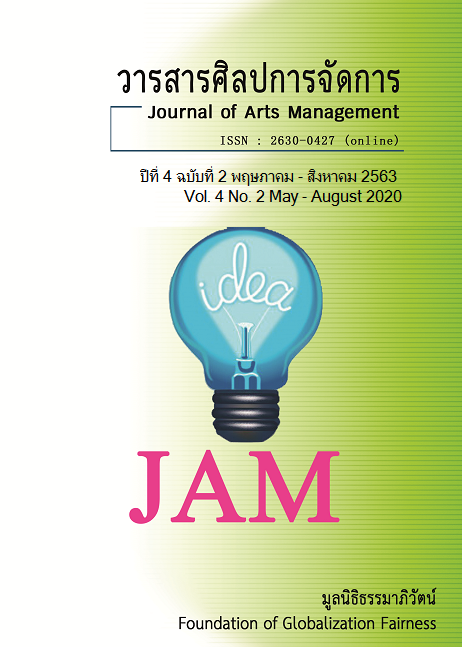Analysis of the Components of the Indicators for Participatory Management as per the House, Temple, and School Concept which Impact the Efficiency of the Management of the School Under the Responsibility of the Primary Educational Service Area Office
Main Article Content
Abstract
This research article aims to study the operational efficiency of a school under the responsibility of the Primary Educational Service Area Office (PESAO) and to analyze the components of the indicators for participatory management as per the House, Temple, and School Concept from the Primary Educational Service Area Office (PESAO). The research sample consists of a total of 388 teachers and officials who work in the school. The data was collected using survey questionnaires. The statistics was used to analyze the data including mean and standard deviation, to test the appropriateness of the data using Kaiser-Meyer-Olkin and Bartlett’s Test Sphericity, and to carry out the Exploratory Factor Analysis of the research indicators. It was found that 1) the overall operational efficiency of the school under the responsibility of the Primary Educational Service Area Office (PESAO) is at a high level and 2) components of the indicators for participatory management as per the house, temple, and school concept of the Primary Educational Service Area Office (PESAO) are made up of six components consisting of 1) planning and cooperation, 2) role and participation, 3) organizing activities and building relationships, 4) management and operations, 5) promoting ethics and morals, and 6) strengthening mutual benefits. All the variables have a variance of 73.72%.
Article Details
Views and opinions appearing in articles in the Journal of Arts of Management It is the responsibility of the author of the article. and does not constitute the view and responsibility of the editorial team I agree that the article is copyright of the Arts and Management Journal.
References
กันยารัตน์ แย้มศรีแก้ว. (2558). การบริหารจัดการความร่วมมือของบ้าน วัด โรงเรียน. วิทยานิพนธ์ปรัชญาดุษฎีบัณฑิต สาขาการบริหารการศึกษา มหาวิทยาลัยศิลปากร.
คณะกรรมการการประถมศึกษาแห่งชาติ, สำนักงาน. (2545). พระราชบัญญัติการศึกษาแห่งชาติพ.ศ.2542 และที่แก้ไขเพิ่มเติม (ฉบับที่ 2) พ.ศ.2545. กรุงเทพฯ: พริกหวานกราฟฟิค.
คณะกรรมการการศึกษาขั้นพื้นฐาน, สำนักงาน. (2562). ระบบสารสนเทศเพื่อการบริหารการศึกษา. สืบค้นเมื่อ 14 สิงหาคม 2562. จาก https://data.bopp-obec.info/emis/
คณะกรรมการพัฒนาการเศรษฐกิจและสังคมแห่งชาติ, สำนักงาน. (2545). แผนพัฒนาเศรษฐกิจและสังคมแห่งชาติฉบับที่ 9 พ.ศ. 2545 – 2549. กรุงเทพฯ: สำนักงานคณะกรรมการพัฒนาการเศรษฐกิจและสังคมแห่งชาติ.
ชูชาติ พ่วงสมจิตร. (2560). การสร้างความสัมพันธ์ระหว่างโรงเรียนกับชุมชน. วารสาร Veridian E-Journal, 10(2), 1342-1354.
พจนารถ วาดกลิ่น. (2556). ความสัมพันธ์ระหว่างการบริหารแบบมีส่วนร่วมกับการดำเนินงานบริหารวิชาการ โรงเรียนในสำนักงานเขตบางกอกใหญ่ สังกัดสำนักการศึกษา กรุงเทพมหานคร.วิทยานิพนธ์ศึกษาศาสตรมหาบัณฑิต สาขาเทคโนโลยีการบริหารการศึกษา มหาวิทยาลัยเทคโนโลยีราชมงคลธัญบุรี.
พิชาย รัตนดิลก ณ ภูเก็ต. (2552). องค์การและการบริหารจัดการ. นนทบุรี: ธิงค์ บียอนด์ บุ๊คส์.
พิมพ์พรรณ เทพสุเมธา และ นุชนาถ สุนทรพันธ์. (2542). ประวัติการศึกษาไทย. กรุงเทพฯ: สำนักพิมพ์มหาวิทยาลัยรามคำแหง.
ยุรนันท์ ตามกาล. (2557). บวรกับการใช้วิถีเศรษฐกิจพอเพียงในการเสริมความเข้มแข็งของชุมชน.
วารสาร Journal of HRintelligence, 9(1), 12-31.
เยาวภา ประคองศิลป์. (2549). ความจำเป็นของการจัดการศึกษาแบบมีส่วนร่วมระหว่างบ้านวัดและโรงเรียน เอกสารประกอบการเสวนาวิชาการทางการศึกษาวันที่ 30 มิถุนายน 2549. ขอนแก่น: คณะศึกษาศาสตร์ มหาวิทยาลัยขอนแก่น.
ศูนย์ศึกษาพระพุทธศาสนาวันอาทิตย์. (2563). การขับเคลื่อนแหล่งเรียนรู้ศีลธรรมของชุมชน. สืบค้นเมื่อ 18 มกราคม 2563. จาก https://www.dra.go.th/site.2560/about.Thai-29-224-0-0.0.html.
สมบูรณ์ สุริยวงศ์, สมจิตรา เรืองศรี และเพ็ญศรี เศรษฐวงศ์. (2544). ระเบียบวิธีวิจัย-ทางการศึกษา พิมพ์ครั้งที่ 2. กรุงเทพฯ: โรงพิมพ์ศูนย์ส่งเสริมวิชาการ.
อัจฉรียา ศักดิ์นรงค์. (2549). การมีส่วนร่วมของชุมชนและแนวทางในการจัดการการท่องเที่ยวเชิงเกษตรกรรม: กรณีศึกษาตำบลหนองตะพานอำเภอบ้านค่ายจังหวัดระยอง. ปริญญานิพนธ์วิทยาศาสตร์มหาบัณฑิต มหาวิทยาลัยครินทรวิโรฒ.
Cohen, John M. and Uphoff, NormanT. (1981). Rural Development Participation: Concepts and Measures for ProjectDesign. Implementation and Evaluation. New York: The Rural Development Committee Center for international studies, Cornell University.
Mott, P. E. (1972). The characteristic of effective organization. New York: Harper and Row.
Ruth V. Small. (2001). Developing a Collaborative Culture. School Library Media research: Research Journal of American Association of School Librarians, 1-3.
Swansburg, R. M. (1996). Management and leadership for nurse managers. Boston: Jones and Bartlett.


